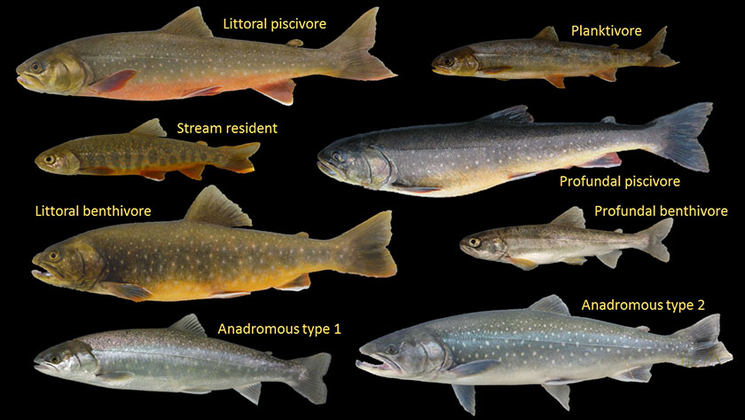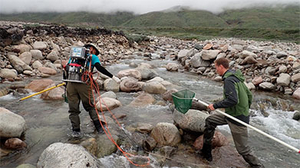Department Fish Ecology and Evolution
Charr migration and ecological divergence

Salmonid fish are one of the most well studied families of fish and have been central in some of the most basic studies in evolution, migration biology and eco-evolutionary dynamics. The Arctic charr (Salvelinus alpinus) exhibits a circumpolar distribution in the Northern Hemisphere. Charrs are a mainly freshwater dwelling species with partial anadromous abilities, inhabiting both lakes and streams. Throughout their distribution, Arctic charr are known to form distinct ecotypes and in some cases even species. Indeed, multiple ecotypes repeatedly evolved in many lakes since the last glaciation period 10-8’000 years ago. In extreme cases up to four different sympatric reproductively isolated ecotypes has been described in a single lake and it is common to find two to three ecotypes in Arctic lakes. Arctic charrs thus represent textbook examples of adaptive radiations.
Funding and duration
Funding: SNSF & EAWAG
Duration: 2014 - ongoing

Greenland provides a unique opportunity to study interactions between intraspecific ecological divergence and migration. The area was completely covered by ice during the last glaciation. After the retreat of the ice, lakes and rivers appeared, which were then colonized by fish. However, due to the large geographic distance to other freshwaters, these newly emerged freshwaters were only colonized by fish species that managed to colonize across the ocean from distant population. The result was that only two species successfully colonized the Greenlandic freshwaters, i.e., the threespine stickleback and Arctic charr. The low number of present freshwater fish species therefore allows to perform comparisons on population, community or whole ecosystem scale in relatively simple natural conditions, which are usually only met in theoretical studies using modeling approaches. Anthropogenic impact on the ecosystems in Greenlandic lakes is almost absent. This stays again in contrast to most Central European lakes. Greenland thus provides a unique study system comprising an almost pristine environment.
Until we started studying charr in 2014, there was only little documentation of charr diversity in Greenland. However, we have now over three field campaigns in Southern Greenland collected more than 5000 individual fish, from 43 lakes in 12 drainage systems, 18 different rivers and streams and four different fjords. All individuals are processed in the field with two types of pictures for color and morphometric analyses, fin clip for DNA analyses and muscle tissue for stable isotope and pigment analyses stored separately. Each fish is measured, weighed and subsequently stored in formalin and shipped to Switzerland, where we currently have a collection of more than 3500 charr from Southern Greenland.
Based on our initial analyses of drainage systems in Southern Greenland, we have found clear ecological segregation between different sympatric morphs, distinct migratory forms related to foraging patterns and very distinct reproductive isolation between several sympatric ecomorphs. Radiations are replicated across drainage systems, with varying degree of different reproductively isolated ecomorphs. From our initial analyses, it is clear that migration plays a central role in the adaptive radiations of charr.

